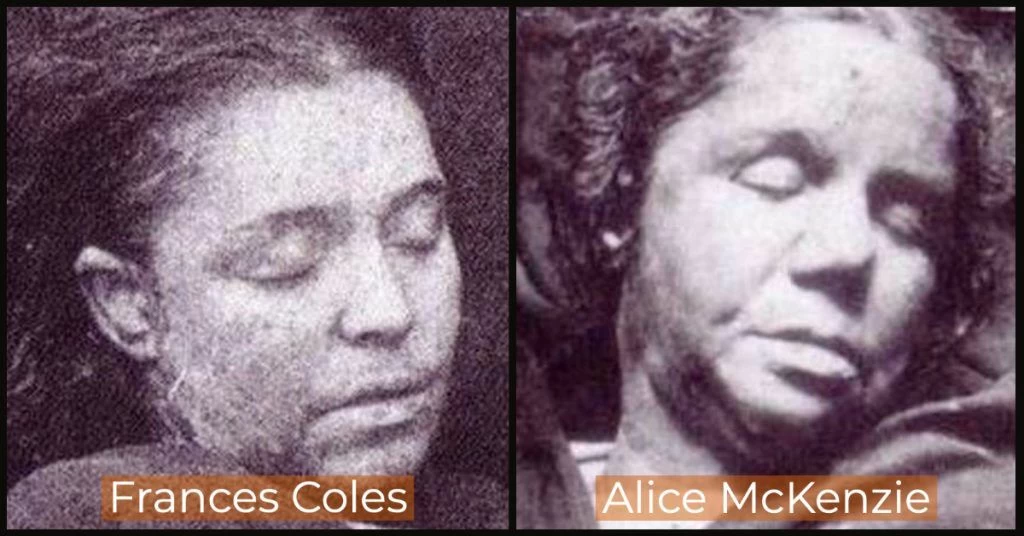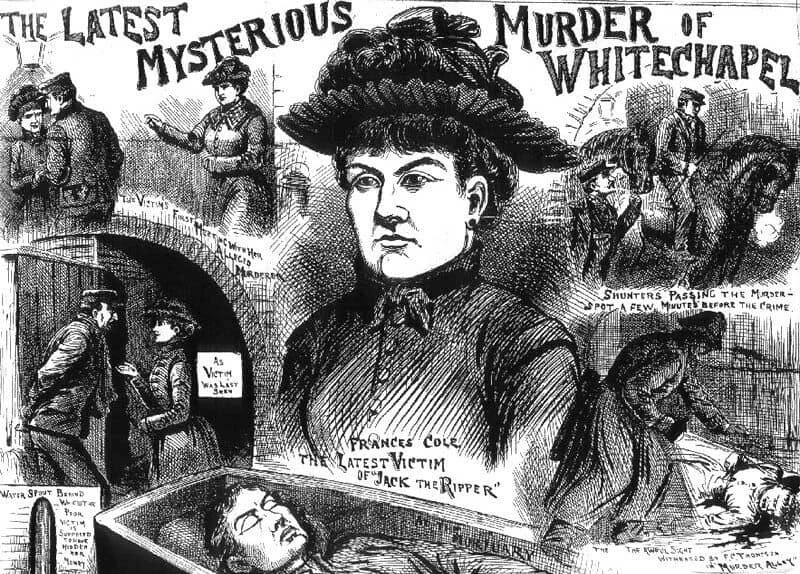Most people are familiar with the name “Jack the Ripper” and the five brutal murders he committed in the summer and autumn of 1888. What many people may not know is that there were two other victims of Jack the Ripper which were identified by notable lawmen and newspapers.

Other Victims of Jack the Ripper
Alice McKenzie
On July 17, 1889, at approximately 12:50 am, a police sergeant was summoned by the whistle of another policeman to a gruesome scene. “…on the right-hand side of the footpath I saw a woman laying on her right side with her clothes halfway up her waist exposing her abdomen. I noticed a quantity of blood under her head on the footway. The [policeman] said ‘here’s another murder’.” Her throat had been slit.
The body, later identified as that of Alice McKenzie, was still warm to the touch and the policeman who had been walking the beat testified that McKenzie’s body had not been there at 12:30 am.
In the following days one man was arrested briefly for the crime and another man confessed to all of the Ripper crimes. Both were released, with the latter being declared insane.
Was this the work of Jack the Ripper? The official opinion was divided. James Munro, the Chief Commissioner of Police stated: “…in spite of ample police precautions and vigilance the assassin has again succeeded in committing a murder and getting off without leaving the slightest clue to his identity.”
Dr. George Phillips, a police surgeon who examined Alice McKenzie’s body, stated otherwise: “After careful and long deliberation I cannot satisfy myself…that the perpetrator of all the ‘Whitechapel Murders’ is (the same) man (who killed Alice McKenzie).”
The investigation into the murder of Alice McKenzie continued in the following weeks and months but the case was never solved.
Months after 1889 passed without other victims of Jack the Ripper surfacing. The citizens of the East End of London may have breathed a sigh of relief and come to the conclusion that the Ripper had stopped, was in prison on some other charge or, hopefully, was dead.
Frances Coles
But on February 13, 1891, a young policeman out walking his beat for the very first time got a shock. The Times newspaper reported:
…he could distinguish the form of a woman lying in the middle of the roadway…she was lying on her back with her legs crossed at the feet…. The throat of the unfortunate woman was severed at the spinal column and blood was flowing freely….

Surprisingly, the woman appeared to still be alive and the policeman later stated that he had heard running footsteps in the distance. He seemed to have interrupted the killer. The policeman blew his whistle to summon fellow officers.
The woman died soon after and was examined by two doctors who analyzed the crime and the body of the victim. She was later identified as Frances Coles, a prostitute who had been living in the infamous Whitechapel area of London for at least eight years.
Again, an arrest was made but the suspect would eventually be released without charge.
Jack the Ripper Still at Large
The Times newspaper soon proclaimed: “The place, the time, and character of the victim, and other points of resemblance, recall in the most obvious way the series of crimes associated in the popular mind with the so-called ‘Jack the Ripper’.” Another newspaper went further and bluntly stated that “the Whitechapel monster (is) still at large.”
As with Alice McKenzie, opinions of law enforcement differed on whether to include Frances Coles in the Ripper canon.
No later murdered women were seriously associated with Jack. Were McKenzie and Coles the other victims of Jack the Ripper? Or were they the focus of a copycat killer(s)? And the question remains that if Coles was his final victim, what happened to him after early 1891?
Once again, as he had in late 1888, the specter of Jack appears to have caused a blind panic and then disappeared into the heavy London fog.
Related Articles:
Gao Chengyong: China’s Jack the Ripper
Jack the Ripper: The First Celebrity Killer
The Dating Game Serial Killer
Jack the Ripper Suspects: Francis Tumblety
On Amazon: Unsolved Murders in Victorian and Edwardian London